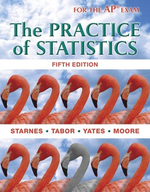Solution Found!
Answer: Section I: Multiple Choice Choose the best answer for Questions AP1.1 to AP1.14
Chapter 4, Problem AP1.4(choose chapter or problem)
Section I: Multiple Choice Choose the best answer for Questions AP1.1 to AP1.14.
For a certain experiment, the available experimental units are eight rats, of which four are female (F1, F2, F3, F4) and four are male (M1, M2, M3, M4). There are to be four treatment groups, A, B, C, and D. If a randomized block design is used, with the experimental units blocked by gender, which of the following assignments of treatments is impossible?
(a) \(A \rightarrow (F 1, \ M 1), \ B \rightarrow (F 2, \ M 2)\)
\(C \rightarrow (F 3, \ M 3), \ D \rightarrow (F 4, \ M 4)\)
(b) \(A \rightarrow (F 1, \ M 2), \ B \rightarrow (F 2, \ M 3)\)
\(C \rightarrow (F 3, \ M 4), \ D \rightarrow (F 4, \ M 1)\)
(c) \(A \rightarrow (F 1, \ M 2), \ B \rightarrow (F 3, \ F 2)\)
\(C \rightarrow (F 4, \ M 1), \ D \rightarrow (M 3, \ M 4)\)
(d) \(A \rightarrow (F 4, \ M 1), \ B \rightarrow (F 2, \ M 3)\)
\(C \rightarrow (F 3, \ M 2), \ D \rightarrow (F 1, \ M 4)\)
(e) \(A \rightarrow (F 4, \ M 1), \ B \rightarrow (F 1, \ M 4)\)
\(C \rightarrow (F 3, \ M 2), \ D \rightarrow (F 2, \ M 3)\)
Questions & Answers
QUESTION:
Section I: Multiple Choice Choose the best answer for Questions AP1.1 to AP1.14.
For a certain experiment, the available experimental units are eight rats, of which four are female (F1, F2, F3, F4) and four are male (M1, M2, M3, M4). There are to be four treatment groups, A, B, C, and D. If a randomized block design is used, with the experimental units blocked by gender, which of the following assignments of treatments is impossible?
(a) \(A \rightarrow (F 1, \ M 1), \ B \rightarrow (F 2, \ M 2)\)
\(C \rightarrow (F 3, \ M 3), \ D \rightarrow (F 4, \ M 4)\)
(b) \(A \rightarrow (F 1, \ M 2), \ B \rightarrow (F 2, \ M 3)\)
\(C \rightarrow (F 3, \ M 4), \ D \rightarrow (F 4, \ M 1)\)
(c) \(A \rightarrow (F 1, \ M 2), \ B \rightarrow (F 3, \ F 2)\)
\(C \rightarrow (F 4, \ M 1), \ D \rightarrow (M 3, \ M 4)\)
(d) \(A \rightarrow (F 4, \ M 1), \ B \rightarrow (F 2, \ M 3)\)
\(C \rightarrow (F 3, \ M 2), \ D \rightarrow (F 1, \ M 4)\)
(e) \(A \rightarrow (F 4, \ M 1), \ B \rightarrow (F 1, \ M 4)\)
\(C \rightarrow (F 3, \ M 2), \ D \rightarrow (F 2, \ M 3)\)
ANSWER:Step 1 of 2
It is impossible for a a treatment group to have two of the same gender.
